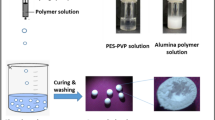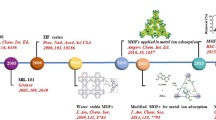Abstract
Here, we suggest a facile and technologically available approach to synthesis of tungsten oxide-based materials implementing a liquid phase reductive precipitation followed by thermal dehydration of the obtained materials. Structure of the investigated sorbents refers to the type of tungsten bronze. Effects of annealing temperature on such properties as chemical and hydromechanical stability along with selective characteristics with respect to Sr-90 have been studied. Sorption investigations in static and dynamic regimes were done on micro- and macro-concentrations of strontium within 2–12 pH range in water solutions. Material’s selectivity to strontium has been assessed in the presence of such competing ions as Na+, K+, NH4+ and Ca2+. Respective constant values for Freundlich, Langmuir, and Langmuir–Freundlich equations have been evaluated for prepared samples. Full dynamic exchange capacity has been determined in dynamic sorption conditions.








Similar content being viewed by others
References
Knapp FF, Dash A (eds) (2016) Radionuclide generator systems represent convenient production systems to provide therapeutic radionuclides. In: Radiopharmaceuticals for therapy. Springer India, New Delhi, pp 131–157
Khajepour A, Rahmani F (2017) An approach to design a 90 Sr radioisotope thermoelectric generator using analytical and Monte Carlo methods with ANSYS, COMSOL, and MCNP. Appl Radiat Isot 119:51–59. https://doi.org/10.1016/j.apradiso.2016.11.001
O’Brien RC, Ambrosi RM, Bannister NP et al (2008) Safe radioisotope thermoelectric generators and heat sources for space applications. J Nucl Mater 377:506–521. https://doi.org/10.1016/j.jnucmat.2008.04.009
Ryu J, Kim S, Hong H-J et al (2016) Strontium ion (Sr2+) separation from seawater by hydrothermally structured titanate nanotubes: removal vs. recovery. Chem Eng J 304:503–510. https://doi.org/10.1016/j.cej.2016.06.131
Merceille A, Weinzaepfel E, Barré Y, Grandjean A (2012) The sorption behaviour of synthetic sodium nonatitanate and zeolite A for removing radioactive strontium from aqueous wastes. Sep Purif Technol 96:81–88. https://doi.org/10.1016/j.seppur.2012.05.018
Huckman ME, Latheef IM, Anthony RG (1999) Ion exchange of several radionuclides on the hydrous crystalline silicotitanate, UOP IONSIV IE-911. Sep Sci Technol 34:1145–1166. https://doi.org/10.1080/01496399908951086
Dyer A, Pillinger M, Harjula R, Amin S (2000) Sorption characteristics of radionuclides on synthetic birnessite-type layered manganese oxides. J Mater Chem 10:1867–1874. https://doi.org/10.1039/B002435J
Dyer A, Pillinger M, Newton J et al (2000) Sorption behavior of radionuclides on crystalline synthetic tunnel manganese oxides. Chem Mater 12:3798–3804. https://doi.org/10.1021/cm001142v
Hasany SM, Chaudhary MH (1981) Adsorption studies of strontium on manganese dioxide from aqueous solutions. Int J Appl Radiat and Isot 32:899–904. https://doi.org/10.1016/0020-708X(81)90076-4
Griffith CS, Luca V (2004) Ion-exchange properties of microporous tungstates. Chem Mater 16:4992–4999. https://doi.org/10.1021/cm049335w
Möller T, Clearfield A, Harjula R (2002) Preparation of hydrous mixed metal oxides of Sb, Nb, Si, Ti and W with a pyrochlore structure and exchange of radioactive cesium and strontium ions into the materials. Microporous Mesoporous Mater 54:187–199. https://doi.org/10.1016/S1387-1811(02)00320-7
Griffith CS, Luca V, Hanna JV et al (2009) Microcrystalline hexagonal tungsten bronze. 1. Basis of ion exchange selectivity for cesium and strontium. Inorg Chem 48:5648–5662. https://doi.org/10.1021/ic801294x
Li X, Mu W, Liu B et al (2013) Adsorption kinetic, isotherm and thermodynamic studies of Sr2+ onto hexagonal tungsten oxide. J Radioanal Nucl Chem 298:47–53. https://doi.org/10.1007/s10967-013-2617-5
Bartha L, Kiss AB, Szalay T (1995) Chemistry of tungsten oxide bronzes. In: Bartha L, Lassner E, Schubert W-D, Lux B (eds) The chemistry of non-sag tungsten. Pergamon, Oxford, pp 77–91
Gao T, Jelle BP (2013) Visible-light-driven photochromism of hexagonal sodium tungsten bronze nanorods. J Phys Chem C 117:13753–13761. https://doi.org/10.1021/jp404597c
Tilley RJD (1995) The crystal chemistry of the higher tungsten oxides. In: Bartha L, Lassner E, Schubert W-D, Lux B (eds) The chemistry of non-sag tungsten. Pergamon, Oxford, pp 93–109
Reise KP, Prince E, Stanley Whittingham M (1992) Rietveld analysis of sodium tungstate hydrate NaxWO3+x/2×yH2O, which has the hexagonal tungsten bronze structure. Chem Mater 4:307–312. https://doi.org/10.1021/cm00020a016
Luca V, Drabarek E, Chronis H, McLeod T (2006) Tungsten bronze-based nuclear waste form ceramics. Part 3: the system Cs0.3MxW1−xO3 for the immobilization of radio cesium. J Nucl Mater 358:164–175. https://doi.org/10.1016/j.jnucmat.2006.06.019
Mu W, Yu Q, Wei H et al (2017) Porous three-dimensional reduced graphene oxide merged with WO3 for efficient removal of radioactive strontium. Appl Surf Sci 423:1203–1211. https://doi.org/10.1016/j.apsusc.2017.06.206
Li X, Mu W, Xie X et al (2014) Strontium adsorption on tantalum-doped hexagonal tungsten oxide. J Hazard Mater 264:386–394. https://doi.org/10.1016/j.jhazmat.2013.11.032
Liu B, Mu W, Xie X et al (2015) Enhancing the adsorption capacity of Sr 2+ and Cs + onto hexagonal tungsten oxide by doped niobium. RSC Adv 5:15603–15611. https://doi.org/10.1039/C4RA13161D
Chang HY, Sivakumar T, Ok KM, Halasyamani PS (2008) Polar hexagonal tungsten bronze-type oxides: KNbW2O9, RbNbW2O9, and KTaW2O9. Inorg Chem 47:8511–8517. https://doi.org/10.1021/ic800573k
Mu W, Yu Q, Li X et al (2017) Efficient removal of Cs+ and Sr2+ from aqueous solution using hierarchically structured hexagonal tungsten trioxide coated Fe3O4. Chem Eng J 319:170–178. https://doi.org/10.1016/j.cej.2017.02.153
Zhang X, Wu Y, Wu H, Wei Y (2016) Adsorption behaviors of strontium using macroporous silica based hexagonal tungsten oxide. Sci China Chem 59:601–608. https://doi.org/10.1007/s11426-015-5553-0
Luca V, Griffith CS, Drabarek E, Chronis H (2006) Tungsten bronze-based nuclear waste form ceramics. Part 1. Conversion of microporous tungstates to leach resistant ceramics. J Nucl Mater 358:139–150. https://doi.org/10.1016/j.jnucmat.2006.06.017
Reis KP, Ramanan A, Whittingham MS (1992) Synthesis of novel compounds with the pyrochlore and hexagonal tungsten bronze structures. J Solid State Chem 96:31–47. https://doi.org/10.1016/S0022-4596(05)80294-4
Szilágyi IM, Madarász J, Pokol G et al (2008) Stability and controlled composition of hexagonal WO3. Chem Mater 20:4116–4125. https://doi.org/10.1021/cm800668x
Acknowledgements
The work was partially supported by RFBR (project 19–33-90150) in terms of developing new methods of sorbents synthesis and their physicochemical characterization. Also, developing the methods of analytical determination of precise radionuclide quantities in the solutions after selective sorption and in the bulk of the sorption matrixes was partially supported within the frames of the State Order of the Institute of Chemistry FEBRAS (project no. 0265–2019-0002). The use of Shimadzu equipment in the work is financially supported by Genzo Shimadzu scholarship.
Author information
Authors and Affiliations
Corresponding author
Additional information
Publisher's Note
Springer Nature remains neutral with regard to jurisdictional claims in published maps and institutional affiliations.
Rights and permissions
About this article
Cite this article
Egorin, A.M., Dran’kov, A.N., Didenko, N.V. et al. Synthesis and sorption characteristics of tungsten oxides-based materials for Sr-90 removal from water media. J Mater Sci 55, 9374–9384 (2020). https://doi.org/10.1007/s10853-020-04683-7
Received:
Accepted:
Published:
Issue Date:
DOI: https://doi.org/10.1007/s10853-020-04683-7




